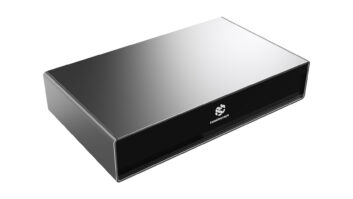Tokyo – Nine major consumer electronics companies announced they have jointly established the basic specifications for a next-generation large capacity optical disc video recording format that will be capable of recording and playing back, among other things, HDTV programming.
Companies involved in the announcement of specifications and plans for licensing the technology included — Hitachi, LG Electronics, Matsushita, Pioneer, Royal Philips Electronics, Samsung, Sharp, Sony and Thomson Multimedia.
All will ‘actively promote’ the new format and will begin a licensing system as soon as specifications are completed. Licensing is expected to start around spring 2002.
The specification — called ‘Blu-ray Disc’ — enables the recording, rewriting and play back of up to 27 gigabytes (GB) of data on a single-sided single-layer disc that is the same size as standard CDs and DVDs. A Blu-ray Disc will record over 2 hours of digital high-definition video and more than 13 hours of standard TV broadcasts (VHS/standard definition picture quality, 3.8Mbps). In addition, the high bitrate (36Mbps) capability of the system will enable recording high-definition images from digital video cameras, while the random access capabilities of the disc will simplify and add greater flexibility to video editing.
The system employs a short wave length (405nm) blue-violet laser for high density reading and recording. The Blu-ray Disc technology uses a field lens with a numerical aperture (NA) to converge the laser into a narrow beam spot. In addition, a new disc structure with a 0.1mm optical transmittance protection layer diminishes aberration caused by disc tilt, making it easier for the laser to read the compressed pits on the disc while increasing the recording density. The Blu-ray Disc’s tracking pitch is reduced to 0.32um, almost half of that of a regular DVD, achieving up to 27 GB high-density recording on a single sided disc. An optical disc cartridge will be used to protect the media dust and fingerprints.
The Blu-ray Disc technology uses the standard MPEG-2 Transport Stream compression technology used in today’s DVDs DTV signals and some satellite TV signals, making for discs that are ‘highly compatible with digital broadcasting for video recording.’
According to a Blu-ray consortium statement, ‘it is possible for the Blu-ray Disc to record digital high definition broadcasting while maintaining high quality and other data simultaneously with video data if they are received together.’
Each disc will carry ‘a unique ID’ to enable high-quality copyright protection systems.
The nine companies plan to ‘respectively develop products that take full advantage of Blu-ray Disc’s large capacity and high-speed data transfer rate.’
Founding companies are also working to expand the capabilities of the Blu-ray Disc format to over 30GB on a single- sided single-layer disc and over 50GB on a single- sided double-layer disc. The announcement also indicated that adoption of the Blu-ray Disc in a variety of applications including PC data storage and high definition video software is being considered.













